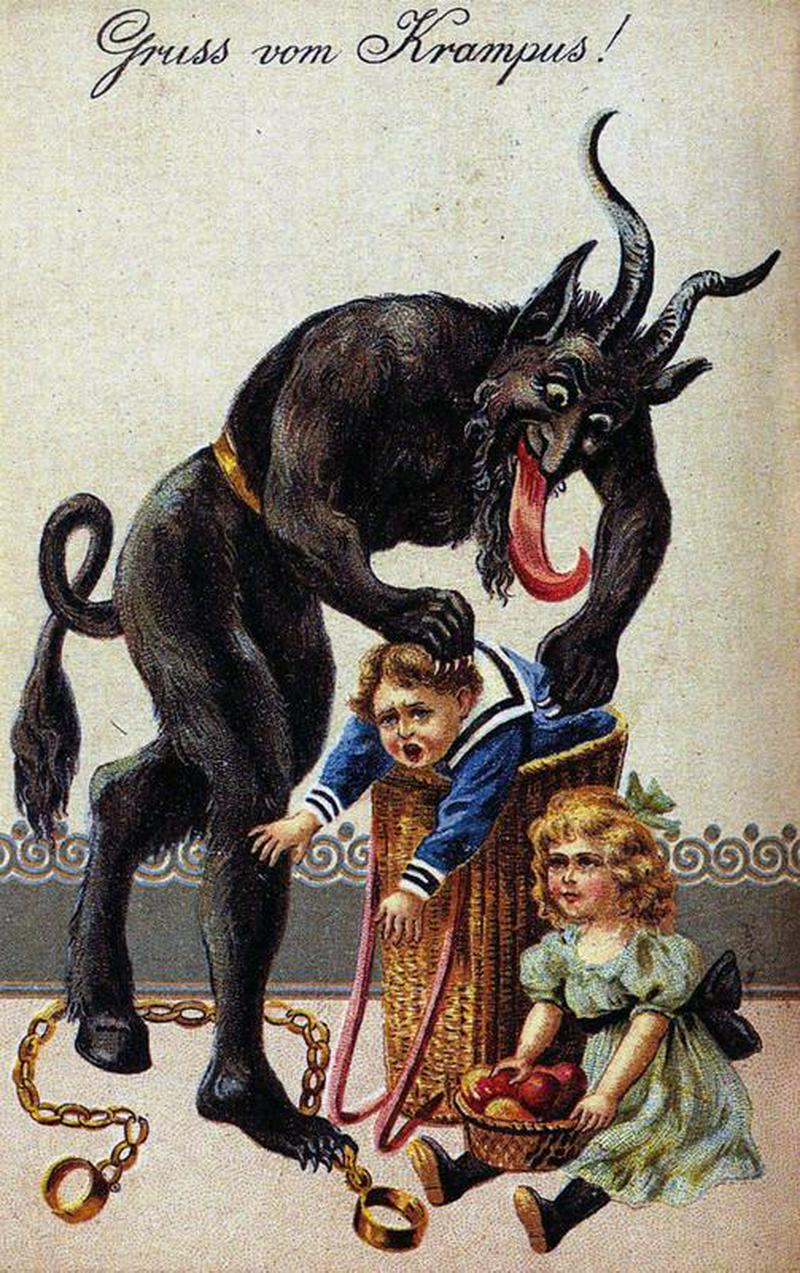Krampus: Full History Of The 2000s' Favorite Christmas Villain
By | December 3, 2019
Krampus is gonna getcha
Now you've done it. You dropped the moral ball, and per tradition, Krampus will come for you on December 5. (Don't even pretend you don't know what you did.) While Santa hands out gifts to everyone on his "nice" list, his demonic buddy, Krampus, brutally punishes children who dare to commit even the most minor of sins. Who is this Germanic yuletide bad boy with a seemingly endless supply of tree branches? Why have Americans begun celebrating the switch-bearing yang to Santa's yin?

According to legend, Krampus and Saint Nicholas travel together throughout Europe the night before Saint Nicholas Day, doling out pain and pleasure in tandem. While Saint Nicholas places candy in the shoes of good little children, Krampus beats bad children with birch branches. If the kids are really horrible, he stuffs them in his sack and drags them screaming and crying back to his lair, where he either tortures them, eats them, or banishes them to hell, depending on who's telling the story. Either way, it seems a bit extreme for some temper tantrums.
The yuletide demon predates Christmas

Even though he's been absorbed into the Christmas tradition over the last few centuries, Krampus actually originated in the days of pre-Germanic paganism in northern Europe. His name comes from the German krampen, which means "claw," and before he was Saint Nicholas's assistant manager, he was the son of Hel, the Norse god of the underworld. His horrifying visage, a demonic goat man with one human foot and one goat foot, ties into a 1,000-year-old pagan ritual that involved dressing up in spooky costumes and running through the streets to dispel the spirits of winter.
His look changed as Christianity became more prevalent

Under the influence of Christianity, the legend of Krampus evolved during the Middle Ages from that of a wintry trickster with a penchant for violence to a youth-assaulting devil. Before Christianity came along and really kicked Krampus's look into high gear, he was what we'd consider a satyr: half-goat, half-man, all testosterone. As Christianity expanded through Europe, however, Krampus was depicted with more satanic overtones, including an obscenely long tongue and chains to bind him. His darkest post-Christian addition by far was the sack or basket that Krampus uses to kidnap children.
Krampus was canceled by the church

Those medieval Christians may have done a little too good of a job. In the 12th century, the Catholic Church put the kibosh of Krampus celebrations because he looked way too much like the devil for their comfort.
Attempts to squash out Krampusnacht have never been all that successful. The next attempt to rid the world of this child-nabbing yule beast came in 1923, when Austrian authorities banned all Krampus-related activities ostensibly for being evil, but also because the fascist government believed him to be a tool created by the Social Democrats to celebrate socialism under their rule. Pamphlets that read "Krampus is an Evil Man" flooded Austria to warn parents of the dangers of this Christmas monster, but the Krampus ban didn't last for long.
You will get a spanking on Krampusnacht

Krampusnacht celebrations returned to Germanic countries in a big way in the late 20th century, even traveling as far as North America. During these raucous events, people dress up like Krampus and prowl the streets in search of unfortunates to swat with their switches, be they delinquent children or just adults who are in their way. The most wholesome of Krampusnacht activities involve handing out Krampus cards and leaving playful threats with friends.
The festivities tend to occur on December 5, but depending on the region, they could also take place a few days before or after. As long as the revelers have Krampus in their hearts, the date doesn't really matter.
Krampus masks are an elaborate tradition

For all of the freewheeling chaos that occurs during Krampusnacht, the people for whom the holiday is a cultural tradition take it very seriously. The outfits they wear are elaborate and handcrafted, the pièce de résistance being the homemade mask. These masks are often painstakingly carved from wood, and as such, they can take months to complete. It's clear from these artisanal masks that Krampus is deeply important to the German and Alpine people.
Krampus swatted his way to America in the 2000s

Until the 2000s, Christmas in America was a fairly Santa-centric affair. Sure, we had grinches, gremlins, and nightmares before Christmas, but our German buddy here became the Christmas baddy du jour after Krampus cards from the 19th century started circulating online. The anti-Santa started appearing everywhere from film and television to greeting cards, giving those who take a more cynical approach to the holiday season a dark horse to support. Ironically, such scrooges now have their own incentive to behave themselves. Not even the most committed misanthrope wants to end up in Krampus's sack of jerks.

